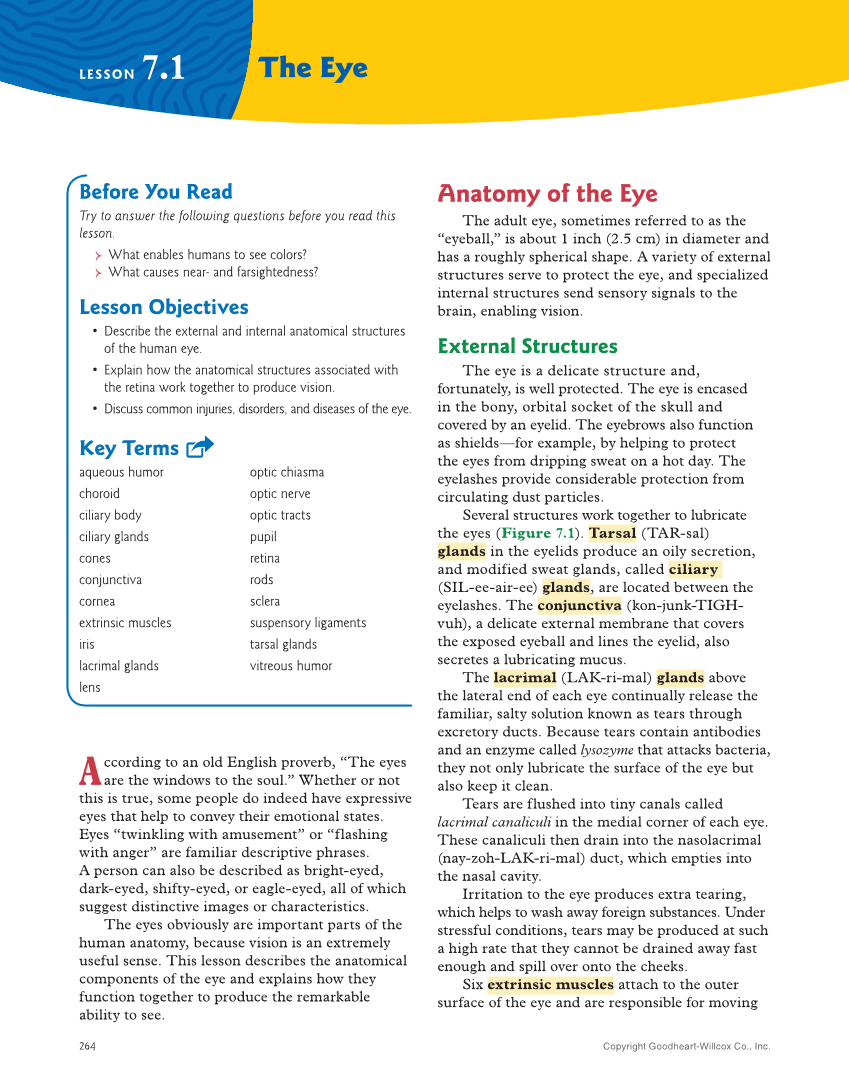264 LESSON 7.1 The Eye Anatomy of the Eye The adult eye, sometimes referred to as the “eyeball,” is about 1 inch (2.5 cm) in diameter and has a roughly spherical shape. A variety of external structures serve to protect the eye, and specialized internal structures send sensory signals to the brain, enabling vision. External Structures The eye is a delicate structure and, fortunately, is well protected. The eye is encased in the bony, orbital socket of the skull and covered by an eyelid. The eyebrows also function as shields—for example, by helping to protect the eyes from dripping sweat on a hot day. The eyelashes provide considerable protection from circulating dust particles. Several structures work together to lubricate the eyes (Figure 7.1). Tarsal (TAR-sal) glands in the eyelids produce an oily secretion, and modified sweat glands, called ciliary (SIL-ee-air-ee) glands, are located between the eyelashes. The conjunctiva (kon-junk-TIGH- vuh), a delicate external membrane that covers the exposed eyeball and lines the eyelid, also secretes a lubricating mucus. The lacrimal (LAK-ri-mal) glands above the lateral end of each eye continually release the familiar, salty solution known as tears through excretory ducts. Because tears contain antibodies and an enzyme called lysozyme that attacks bacteria, they not only lubricate the surface of the eye but also keep it clean. Tears are flushed into tiny canals called lacrimal canaliculi in the medial corner of each eye. These canaliculi then drain into the nasolacrimal (nay-zoh-LAK-ri-mal) duct, which empties into the nasal cavity. Irritation to the eye produces extra tearing, which helps to wash away foreign substances. Under stressful conditions, tears may be produced at such a high rate that they cannot be drained away fast enough and spill over onto the cheeks. Six extrinsic muscles attach to the outer surface of the eye and are responsible for moving Before You Read Try to answer the following questions before you read this lesson. What enables humans to see colors? What causes near- and farsightedness? Lesson Objectives • Describe the external and internal anatomical structures of the human eye. • Explain how the anatomical structures associated with the retina work together to produce vision. • Discuss common injuries, disorders, and diseases of the eye. Key Terms aqueous humor choroid ciliary body ciliary glands cones conjunctiva cornea extrinsic muscles iris lacrimal glands lens optic chiasma optic nerve optic tracts pupil retina rods sclera suspensory ligaments tarsal glands vitreous humor According to an old English proverb, “The eyes are the windows to the soul.” Whether or not this is true, some people do indeed have expressive eyes that help to convey their emotional states. Eyes “twinkling with amusement” or “flashing with anger” are familiar descriptive phrases. A person can also be described as bright-eyed, dark-eyed, shifty-eyed, or eagle-eyed, all of which suggest distinctive images or characteristics. The eyes obviously are important parts of the human anatomy, because vision is an extremely useful sense. This lesson describes the anatomical components of the eye and explains how they function together to produce the remarkable ability to see. Copyright Goodheart-Willcox Co., Inc.
